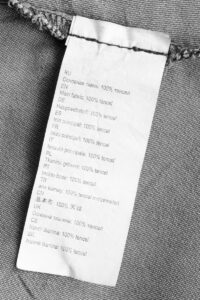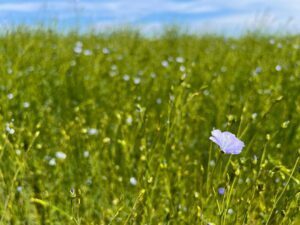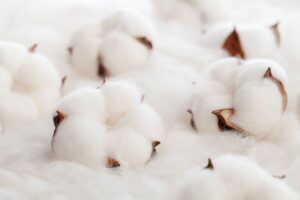Categories
What is the difference between Ecological fibres and Natural fibres?
- Valentine
- No Comments
In the constant evolution of a lifestyle focused on sustainability and respect for the environment, the choice of materials plays a crucial role.
The world of textiles is often driven by two frequently discussed terms: organic fibres and natural fibres.
Although these terms may seem interchangeable, there are significant distinctions between them. In this blog post, we take a look at fibres and examine the differences between organic and natural fibres and their impact on the environment and our well-being.
What is a fibre? What are the different types of fibre?
Before getting into the comparative aspect, a little background is useful. A fibre is a filamentary material used in the textile industry to make fabrics. There are three main categories: natural fibres, man-made fibres and synthetic fibres:
- Natural fibres are derived from natural sources such as plants or animals. For example: cotton, linen, hemp, silk, wool, down, feathers, etc.
- Man-made fibres are derived from a raw material that is often natural (such as wood pulp or soya). More recently, they can also be derived from the pulp of other recycled fibres (natural or man-made cellulose fibres). For the sake of simplicity, we will confine ourselves in this article to talking about man-made fibres derived from wood pulp. There are 3 main families of such artificial fibres:
-
- Lyocell is a fibre created artificially and chemically from eucalyptus wood pulp. Lyocell is the highest quality artificial fibre. There are sustainably produced Lyocells such as Tencel® from the Austrian company Lenzing, which recycles 97-98% of the solvents and chemicals used in the artificial fibre manufacturing process. There are also cheaper Lyocells produced in China and other countries in an environmentally unfriendly way.
-
- Modal is a fibre created artificially and chemically from beechwood pulp. Modal is an artificial fibre of average quality. More sustainably produced Modal is available, such as Modal Edelweiss® from the Austrian company Lenzing, which has found a more environmentally friendly way of creating Modal – although without completely avoiding the use of chemicals. There are also cheaper Modal products from Lenzing, as well as unbranded products produced in China and other countries in an environmentally unfriendly way.
-
- Viscose is a fibre created artificially and chemically from mixed wood pulp. These are often woods that cannot be used to create pellets for heating and other uses. Viscose is a low-quality artificial fibre that is cheaper than its cousins Modal and Lyocell. Viscose is very rarely produced in an environmentally-friendly way, as the chemicals used are very harmful to the environment and are rarely recycled. Only Lenzing has recently been offering a less harmful viscose, Viscose Ecovero™ produced in Europe with 60% European wood pulp and 40% wood pulp of origin not disclosed by the company. Bamboo fibres are also a Viscose (from bamboo). To date, no company has succeeded in creating sustainable bamboo viscose. Bamboo is a very environmentally-friendly wood for making furniture and flooring, but it is an ecological disaster when used to make textile fibres.
- Synthetic fibres are made from petroleum derivatives, such as polyester, nylon, acrylic, elastane, etc.
Natural fibres
Natural fibres can be either organic or conventionally grown. The production of natural fibres does not exclude the use of synthetic chemicals (chemical fertilisers, chemical pesticides and chemical defoliants) or genetically modified organisms (GMOs), making it a diverse category encompassing a wide range of cultivation practices.
Organic or ecological fibres, grown in an environmentally-friendly way
Organic or ecological fibres are grown and processed without the use of synthetic chemicals (chemical fertilisers, chemical pesticides and chemical defoliants) or GMOs. The cultivation of organic fibres aims to reduce the ecological footprint resulting from their production. It is therefore based on practices that respect the environment, preserving soil, water, air, biodiversity and health.
Common examples of organic fibres include organic cotton, organic linen and organic wool. These materials are often preferred by consumers who are looking for products that reflect their values of sustainability and environmental responsibility, who are concerned about the health of the farmers and breeders of these fibres, their families and their communities, and also their own health as users.
How do we compare? Natural fibres versus organic fibres in three main points
You’ve got it… If you read or hear that a product is made from 100% natural fibres, bear in mind that this simply means that it is not made from artificial or synthetic fibres. Not that it is ecological, eco-responsible, organic and healthy for the environment or your health! In short, natural fibres are only fibres that are not synthetic, and they are not automatically sustainable.
Growing methods:
Natural Fibres: These are fibres from organic or natural sources that are conventionally grown, allowing for a wider range of cultivation methods, including chemical inputs (pesticides, fertilisers and defoliants) and the use of GMOs.
Organic Fibres: These are the same fibres but grown without synthetic chemicals (pesticides, fertilisers and defoliants) or GMOs, using environmentally friendly farming practices.
Environmental impact:
Natural fibres: The environmental impact of natural fibres can vary depending on the cultivation methods used. Conventional practices may involve the use of synthetic pesticides, fertilisers and defoliants, as well as GMOs (if they are non-certified natural fibres from organic farming).
Organic fibres: The growing of these fibres tends to have a lower environmental impact due to the absence of synthetic chemicals, the ban on the use of GMOs and the emphasis on sustainable farming practices.
Consumer choices:
Natural fibres: These offer a wide range of choice, allowing consumers to select fibres according to their preferences such as comfort, texture and use.
Organic Fibres: These attract consumers who are looking for products made from natural fibres (with the advantages listed above) but which also conform to sustainable values and respect for the environment and a healthy lifestyle.
The fabrics we choose
At Kalani, we know the origin of each of our raw materials and fabrics (read more here). In addition, 100% of our cotton is certified organic according to the GOTS standard, which is the strictest in the world (read more here). We carefully choose our partners according to their production practices, both in terms of environment and people.
Our linen is grown in Belgium, the Netherlands and France. This vegetable fibre, obtained from the flax plant, is grown in an environmentally-friendly way without the need for chemical inputs.
In fact, there is on our website a “fabrics” page that explains each of them in greater detail here.
In a nutshell…
In the pursuit of a more sustainable and environmentally friendly lifestyle, understanding the nuances between organic and natural fibres is key. While both are natural, organic fibres are distinguished by sustainable farming practices and the exclusion of synthetic chemicals and GMOs.
So the next time you opt for a cotton duvet cover, a cotton t-shirt or a warm woollen jumper, think about the journey of the fibres that compose them and the impact they have on the world around us!





